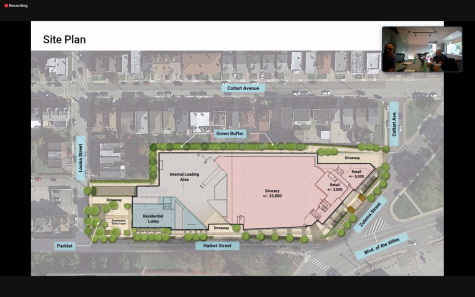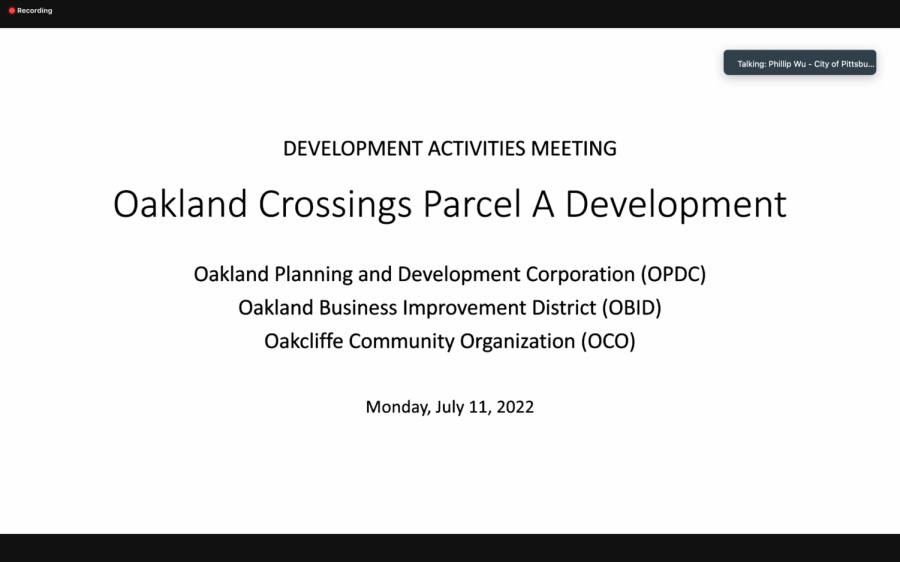Walnut Capital, Oakland community discuss Parcel ‘A’
Monday’s Development Activities meeting to discuss Parcel “A” of Oakland Crossings.
July 12, 2022
When Jon Kamin, an attorney representing Walnut Capital, was asked how Parcel “A” of Oakland Crossings is going to fit into the South Oakland neighborhood, he said the development and management firm was “very proud” of the project design.
“We’re very proud with what we’ve come up with to date, and think that it is really a marquee building for Oakland and particularly as a kickoff for this first project, Parcel ‘A,’” Kamin said.
The City of Pittsburgh hosted a Developmental Activities meeting for Oakland community members Monday evening, over Zoom, to discuss Parcel “A” of Oakland Crossings. The joint meeting was held with the Oakland Planning and Development Corporation, the Oakland Business Improvement District and the Oakcliffe Community Organization.
Walnut Capital and Strada, a building design firm, presented their plans for Parcel “A” for public comment. The proposed project at 3401 Blvd of the Allies includes a grocery store, other retail space, 426 apartment units and a 445-space enclosed parking garage.

Tom Price, principal architect at Strada, discussed the design plans for the proposed development. Price described Parcel “A” as an opportunity to bring new experiences to Oakland that have the potential to “improve Oakland as a community” over time.
“We’re trying to be best in class with pedestrian-friendly streetscape experiences and public open space, and being very diverse in that approach to how we create something that’s engaging, and quality urban living,” Price said. “I mean, obviously, that’s what always has been a great part of Oakland, and so we’re trying to see how we can improve that and sort of augment what already exists. And then provide some new amenities that don’t exist … make something that has longevity and is sustainable over time to improve Oakland as a community.”
Kamin discussed the proposed public benefits of Parcel “A.” According to Kamin, these benefits included 10 percent of residential units designated as “affordable,” commitment to all-union construction for the initial construction of the building, a monetary contribution to workforce training and transportation, accessibility and sustainability measures.
“We’ve also committed to utilizing universal design attributes, which is very important for us to make sure that the project is accessible to all,” Kamin said. “And then we’ve also committed to utilizing green infrastructure techniques to handle the stormwater and the other items that are generated by the project, so that there is a net improvement associated with Walnut’s work.”
Community members submitted questions and comments about the project through Zoom’s chat feature. One community member asked for clarification about the project’s internal loading site and the length of the building. Kamin said the internal loading site is designed to let trucks “pull directly into the site.”
“Internal loading is set up so that there’s really minimal impact to any part of the neighborhood,” Kamin said. “So if you look at the way the driveway is designed here, the delivery trucks will be able to pull directly into the site and maneuver in such a way that they can back up internally load within the site, and then pull back out again and back out Halket Street towards the Boulevard of the Allies. In order to make that internal loading work, you need enough room for maneuvers for a truck that servicing a grocery store to be able to do that. And that’s how the building has been designed to make that work. As far as the 425 feet, that’s what’s permitted under the ordinance and we’re complying with that.”
Han Lempert, an Oakland community member, asked how sidewalks around the development would be maintained for accessibility. In response to this, Kamin said Walnut Capital will do “what is required” by the City.
“Well, we’ll do whatever is required by the city. The accessibility issue is handled by DOMI – that looks at the accessibility around the site and accessible routes – and they will give us, you know, what is required and we will comply with that requirement,” Kamin said.
Several community members were not satisfied with this answer, including Andrea Boykowycz, assistant director of OPDC.
“Would like to encourage the presenters to understand that ‘we will comply with city requirements’ is not an answer to any of the design questions being asked here,” Boykowycz said.
Lempert agreed with Boykowycz.
“I feel ‘compliance’ with ordinances does not hold the connotation of supporting the community and considering the individual who will inhibit this area on a daily basis,” Lempert said.
Kamin said the Parcel “A” plans are “detailed,” and that changes based on input will be made available prior to the Planning Commission meeting about the project.
“All of this will get shared again, we take this input, we’re taking input from CDAP, all of this will get shared in advance of the Planning Commission meeting and will be probably available for comment, review and discourse.”








